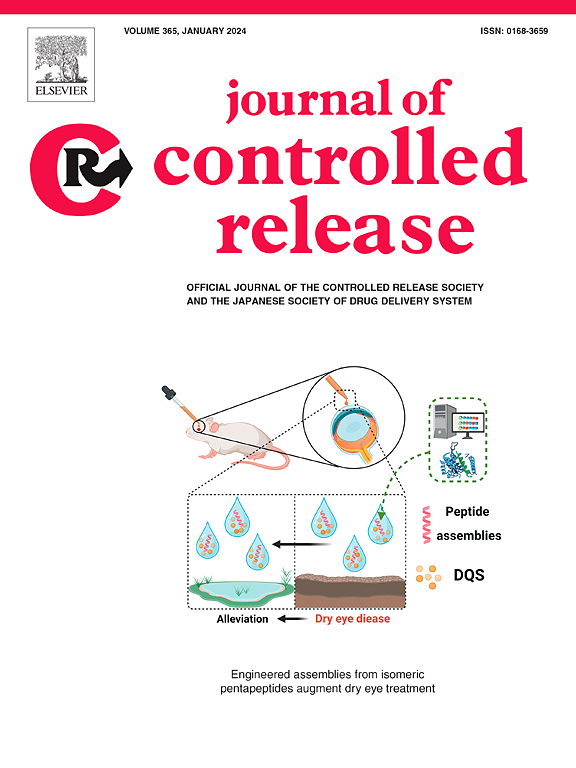纳米凝胶包封改善抗菌肽LL37肺沉积的药代动力学和生物分布:SPECT/CT体内评价
IF 10.5
1区 医学
Q1 CHEMISTRY, MULTIDISCIPLINARY
引用次数: 0
摘要
抗菌肽(AMPs)是人体的第一道防线,外源性应用抗菌肽是对抗细菌感染的理想治疗策略。然而,由于宿主和细菌蛋白酶的快速降解,amp的抗菌特性往往是有时间限制的,并且所需的高剂量施用可能导致局部炎症,以及肾和肝毒性。在这项研究中,我们评估了使用由辛烯基琥珀酸酐修饰的透明质酸(HA-OSA)组成的纳米凝胶作为给药系统的可能性,以改善LL37的药代动力学和安全性,LL37是一种天然存在的AMP,当给药到肺粘膜表面时。肽LL37和聚合物HA-OSA分别用67镓和111铟进行放射性标记,允许在小鼠气管内给药后进行无创跟踪。当给予非配方的LL37时,大约85 %的肽剂量在48 h内从肺部清除,而在HA-OSA纳米凝胶中包封LL37使肺部的肽保留率增加了36% %。此外,排泄器官中肽的数量减少,减少了已知与基于amp的治疗相关的潜在肝脏和肾脏毒性。本研究结果表明,纳米凝胶包封LL37具有有益的药代动力学作用。本文章由计算机程序翻译,如有差异,请以英文原文为准。

Nanogel encapsulation improves pharmacokinetics and biodistribution of antimicrobial peptide LL37 upon lung deposition: In vivo evaluation by SPECT/CT
Antimicrobial peptides (AMPs) constitute the first line of defense in the human body and exogenous application of AMPs is a desirable therapeutic strategy to combat bacterial infections. However, the antibacterial properties of AMPs are often time limited due to fast degradation by host and bacterial proteases, and administration of the needed high doses may result in local inflammation, as well as nephro- and hepatotoxicity. In this study, we assessed the possibility of using nanogels composed of hyaluronic acid modified with octenyl succinic anhydride (HA-OSA) as a drug delivery system to improve the pharmacokinetics and safety profile of LL37, a naturally occurring AMP, when administered to the mucosal surface of the lungs. The peptide LL37 and the polymer HA-OSA were radiolabeled with 67gallium and 111indium, respectively, allowing for non-invasive tracking over time in mice following intratracheal administration. When non-formulated LL37 was administered, approximately 85 % of the peptide dose was cleared from the lungs over 48 h, whereas encapsulation of LL37 in HA-OSA nanogels increased peptide retention in the lungs by 36 %. Additionally, the amount of peptide in excretory organs was reduced, decreasing potential liver and kidney toxicity known to be associated with AMP-based therapies. The findings in this study indicate that encapsulation of LL37 in nanogels provides beneficial pharmacokinetic effects.
求助全文
通过发布文献求助,成功后即可免费获取论文全文。
去求助
来源期刊

Journal of Controlled Release
医学-化学综合
CiteScore
18.50
自引率
5.60%
发文量
700
审稿时长
39 days
期刊介绍:
The Journal of Controlled Release (JCR) proudly serves as the Official Journal of the Controlled Release Society and the Japan Society of Drug Delivery System.
Dedicated to the broad field of delivery science and technology, JCR publishes high-quality research articles covering drug delivery systems and all facets of formulations. This includes the physicochemical and biological properties of drugs, design and characterization of dosage forms, release mechanisms, in vivo testing, and formulation research and development across pharmaceutical, diagnostic, agricultural, environmental, cosmetic, and food industries.
Priority is given to manuscripts that contribute to the fundamental understanding of principles or demonstrate the advantages of novel technologies in terms of safety and efficacy over current clinical standards. JCR strives to be a leading platform for advancements in delivery science and technology.
 求助内容:
求助内容: 应助结果提醒方式:
应助结果提醒方式:


